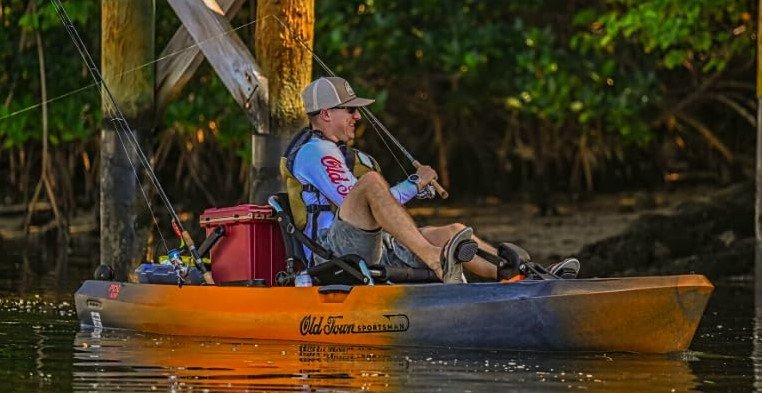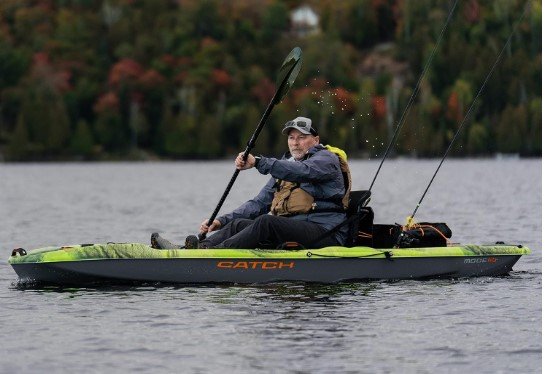
Hey, fellow anglers! If you’re into kayak fishing, you’ve probably wondered whether a pedal or paddle kayak would suit you better. Both types have pros and cons; the right choice depends on your fishing style and preferences. Let’s break down the key differences and help you decide which one might best fit your next fishing adventure.
Pedal Kayaks
Description and Features
Pedal kayaks have a pedal-driven propulsion system, allowing you to move hands-free. These kayaks typically have pedals that drive a propeller or fins underneath the kayak.
 Old Town Sportsman PDL 106 Pedal Fishing Kayak
Old Town Sportsman PDL 106 Pedal Fishing Kayak
Benefits of Using Pedal Kayaks for Fishing
Pedal kayaks offer several advantages, particularly for anglers. The hands-free operation lets you fish, adjust your gear, and manage your catch without putting down a paddle. They also tend to be faster and require less physical effort to cover long distances.
Situations Where Pedal Kayaks Excel
Pedal kayaks are excellent for open waters, long fishing trips, and situations where you must stay in a precise location without drifting. Their ease of use makes them perfect for trolling and covering more water in search of fish.
Paddle Kayaks
Description and Features
Paddle kayaks are the traditional style, propelled by using a double-bladed paddle. They are generally more straightforward in design and can vary significantly in size and stability.
 Pelican Catch Mode 110 Premium
Pelican Catch Mode 110 Premium
Benefits of Using Paddle Kayaks for Fishing
Paddle kayaks are typically lighter, easier to transport, and less expensive than pedal kayaks. They offer a quieter approach, which can be beneficial in calm, shallow waters where stealth is essential.
Situations Where Paddle Kayaks Excel
Paddle kayaks shine in tight spaces, shallow waters, and areas with lots of vegetation or obstacles. They are also ideal for anglers who enjoy the simplicity and physical aspect of paddling.
Comparative Analysis: Pedal vs. Paddle Kayaks
Performance in Different Water Conditions
Pedal kayaks perform better in open waters and strong currents, providing speed and stability. Paddle kayaks are better for maneuvering through narrow streams and shallow areas.
Ease of Use and Learning Curve
Pedal kayaks have a steeper learning curve but become very intuitive with practice. Paddle kayaks are easy to learn, making them accessible for beginners.
Speed and Maneuverability
Pedal kayaks generally offer better speed and less fatigue over long distances. Paddle kayaks, on the other hand, are more maneuverable in tight spots.
Stability and Comfort
Both types can be very stable, but pedal kayaks often have a slight edge in stability due to their design and weight distribution. Comfort levels depend on the model and additional features like seat quality.
Cost Considerations
Price Comparison
Pedal kayaks are typically more expensive, starting around $1,500 and going up from there. Paddle kayaks are more affordable, with quality models available for $500 to $1,000.
Long-Term Investment and Maintenance Costs
Pedal systems require more maintenance and can incur higher repair costs over time. Paddle kayaks have fewer moving parts and are generally more accessible and cheaper to maintain.
Fishing Efficiency and Technique
How Each Type Affects Fishing Techniques
Thanks to their hands-free operation, pedal kayaks allow for more complex fishing techniques like trolling and drift fishing. They also support traditional fishing methods and provide a more tactile connection to the water.
Hands-Free Fishing Advantages
The most significant advantage of pedal kayaks is the ability to fish hands-free, making managing multiple rods and dealing with catches much easier.
Traditional Fishing Techniques
Paddle kayaks excel in traditional fishing techniques that require quiet and precise maneuvering, such as fly fishing in calm waters.
Storage and Transportation
Ease of Storing and Transporting
Paddle kayaks are lighter and easier to store and transport, often fitting on standard roof racks. Pedal kayaks can be bulkier and heavier, sometimes requiring specialized transportation solutions.
Space and Weight Considerations
Consider the available storage space and your ability to transport a heavier kayak. Paddle kayaks are more forgiving in this regard.
Personal Preferences and Fishing Style
How to Choose Based on Preferences
Your choice should reflect your fishing style, physical capabilities, and the environments in which you frequently fish. A pedal kayak might be the best choice if you value speed and hands-free operation. If you prefer simplicity and maneuverability, a paddle kayak could be perfect.
Examples of Anglers Who Prefer Each Type
Many tournament anglers prefer pedal kayaks for their efficiency and hands-free operation. Recreational anglers and those who enjoy fly fishing often prefer paddle kayaks for their simplicity and stealth.
Conclusion
Choosing between a pedal and paddle kayak for fishing ultimately depends on your preferences and fishing needs. Both types offer unique advantages that can enhance your fishing experience differently.
FAQ Section
Q: Are pedal kayaks harder to transport than paddle kayaks?
A: Pedal kayaks are generally heavier and bulkier, making them more challenging to transport than paddle kayaks.
Q: Can I use a pedal kayak in shallow waters?
A: Pedal kayaks can be used in shallow waters, but they are less maneuverable than paddle kayaks and might struggle in very shallow or heavily vegetated areas.
Q: Which type of kayak is better for beginners?
A: Paddle kayaks are generally more accessible for beginners to learn and handle. Pedal kayaks have a steeper learning curve but offer more advantages once mastered.
Choosing the right kayak can significantly impact your fishing success and enjoyment. Weigh the pros and cons of each type to find the perfect fit for your fishing adventures.